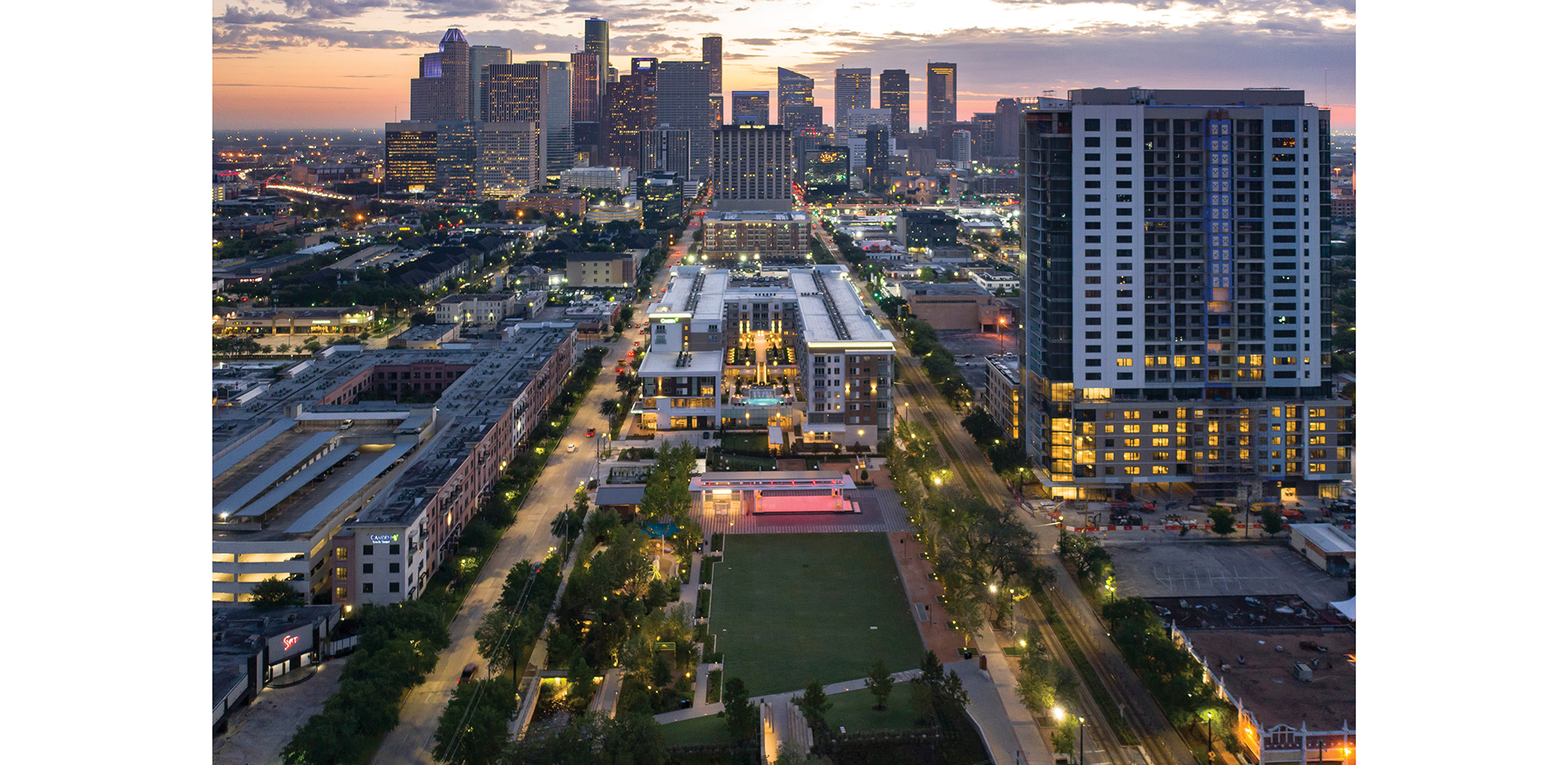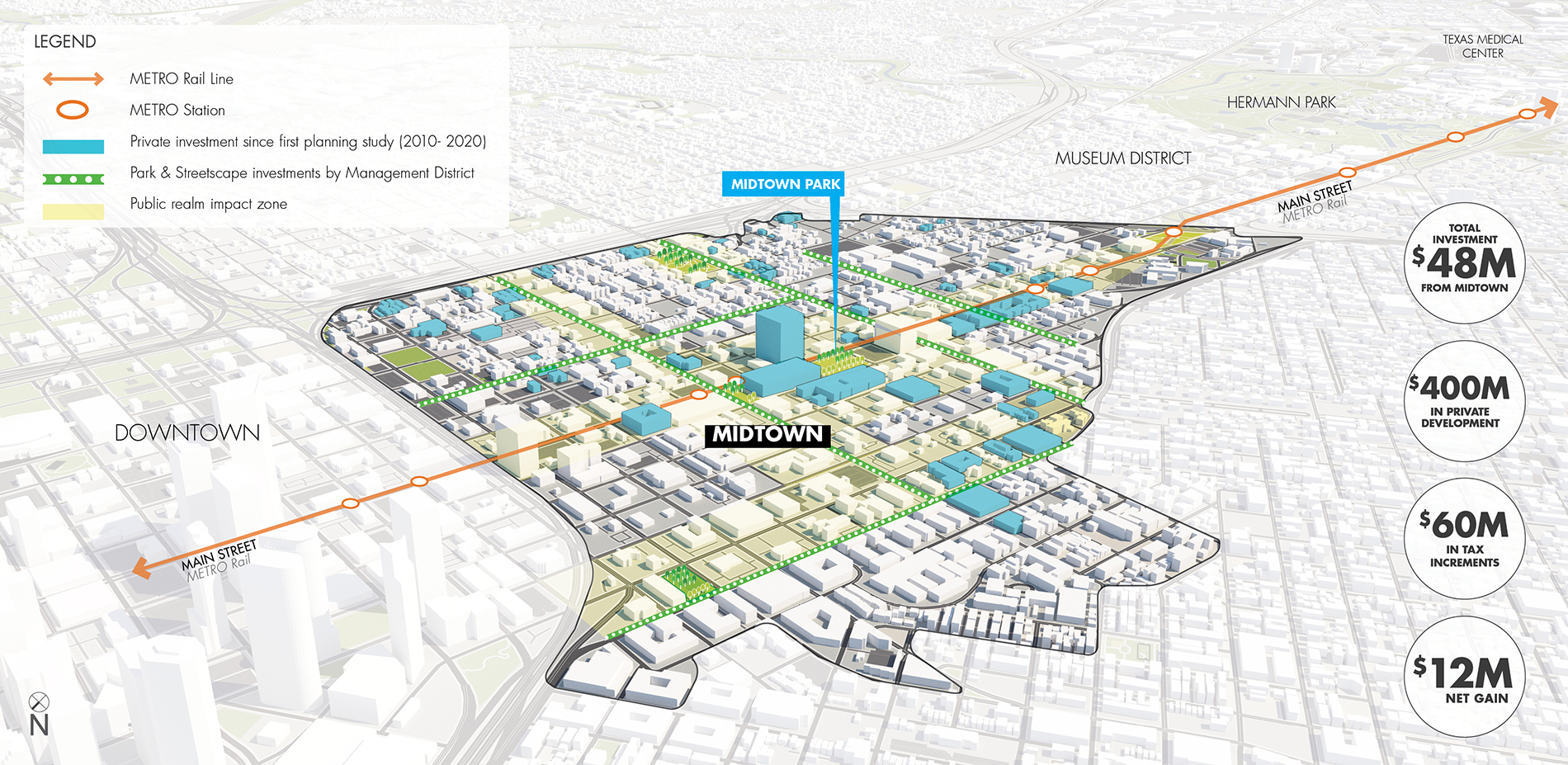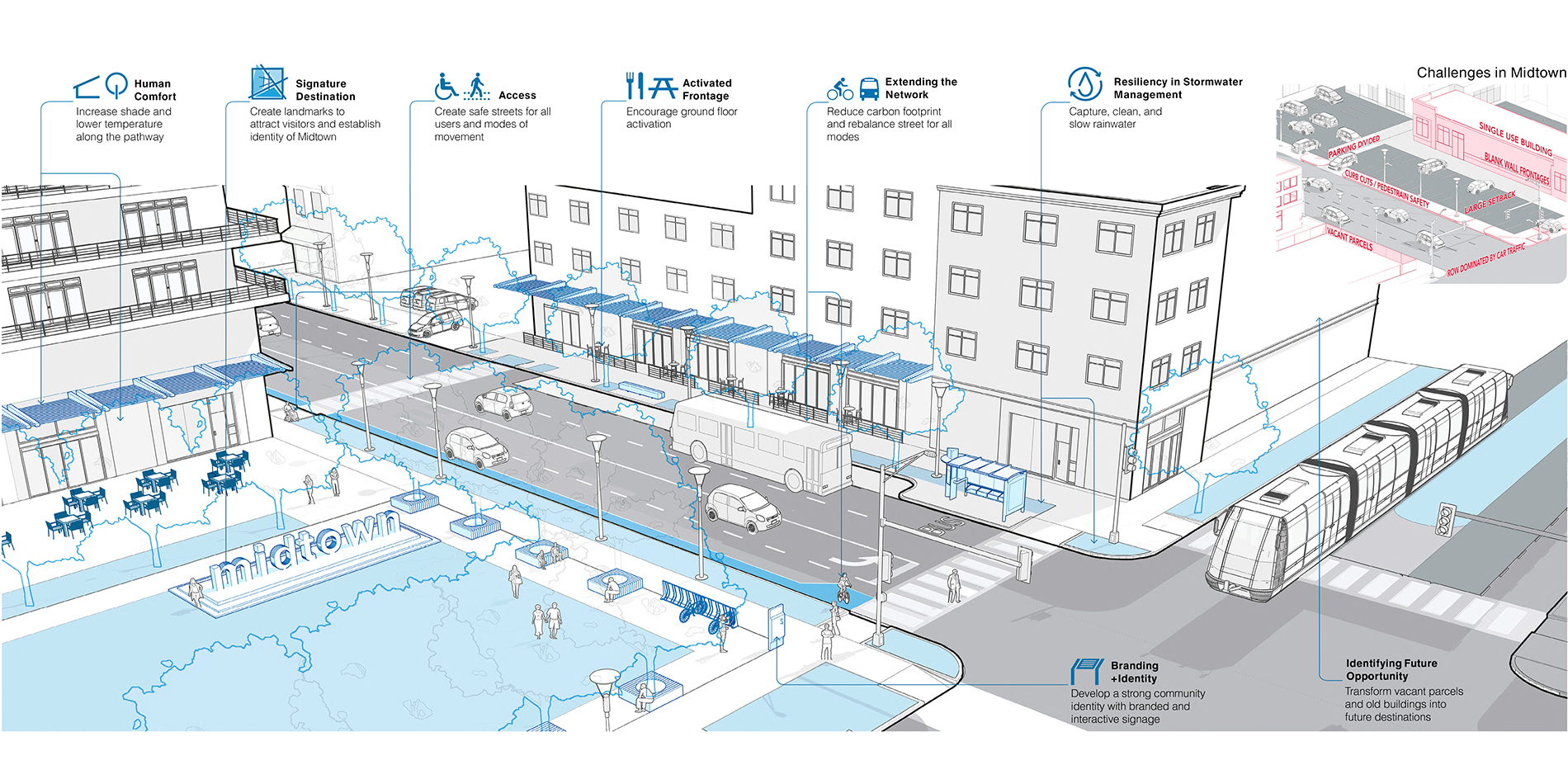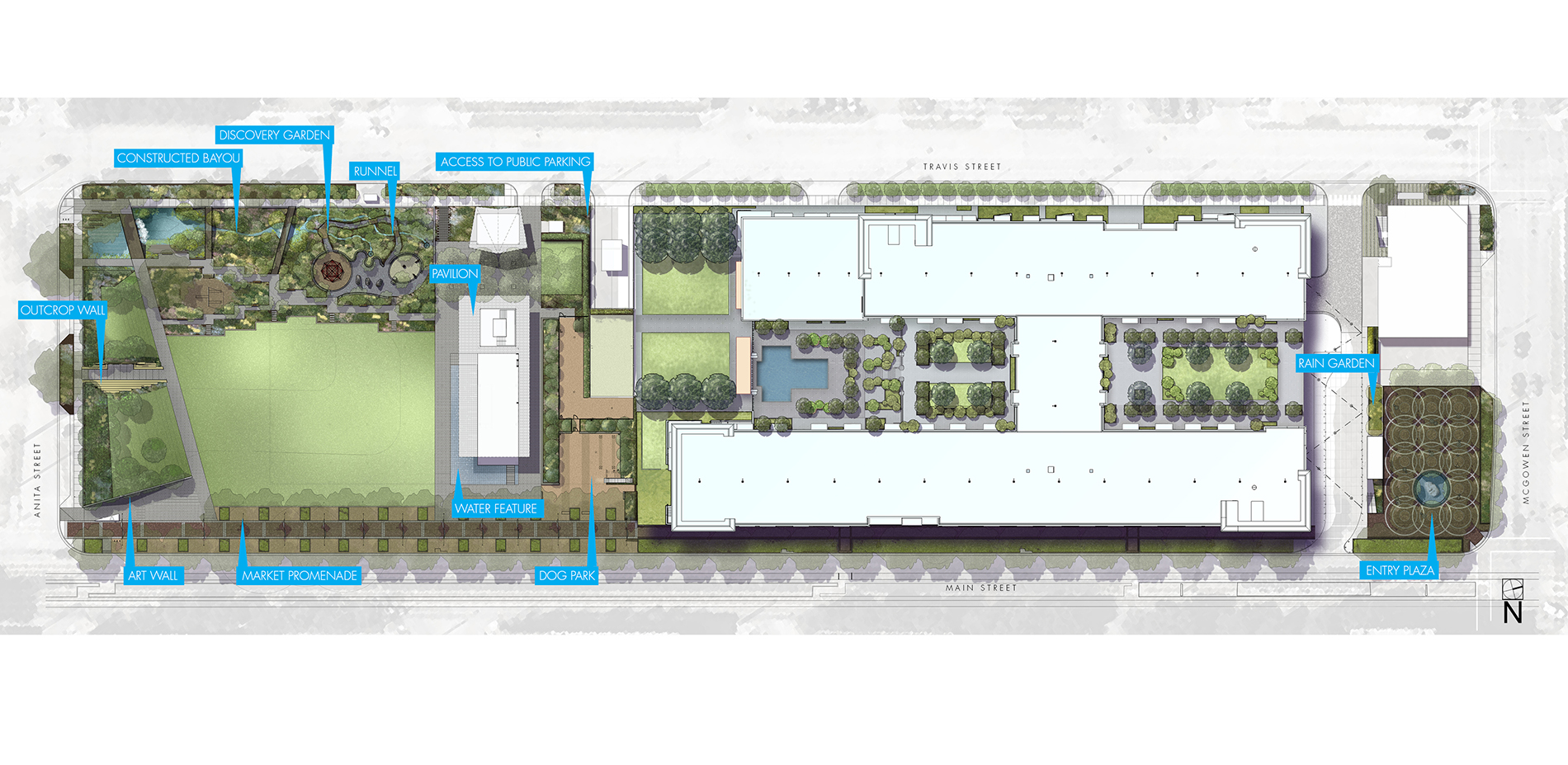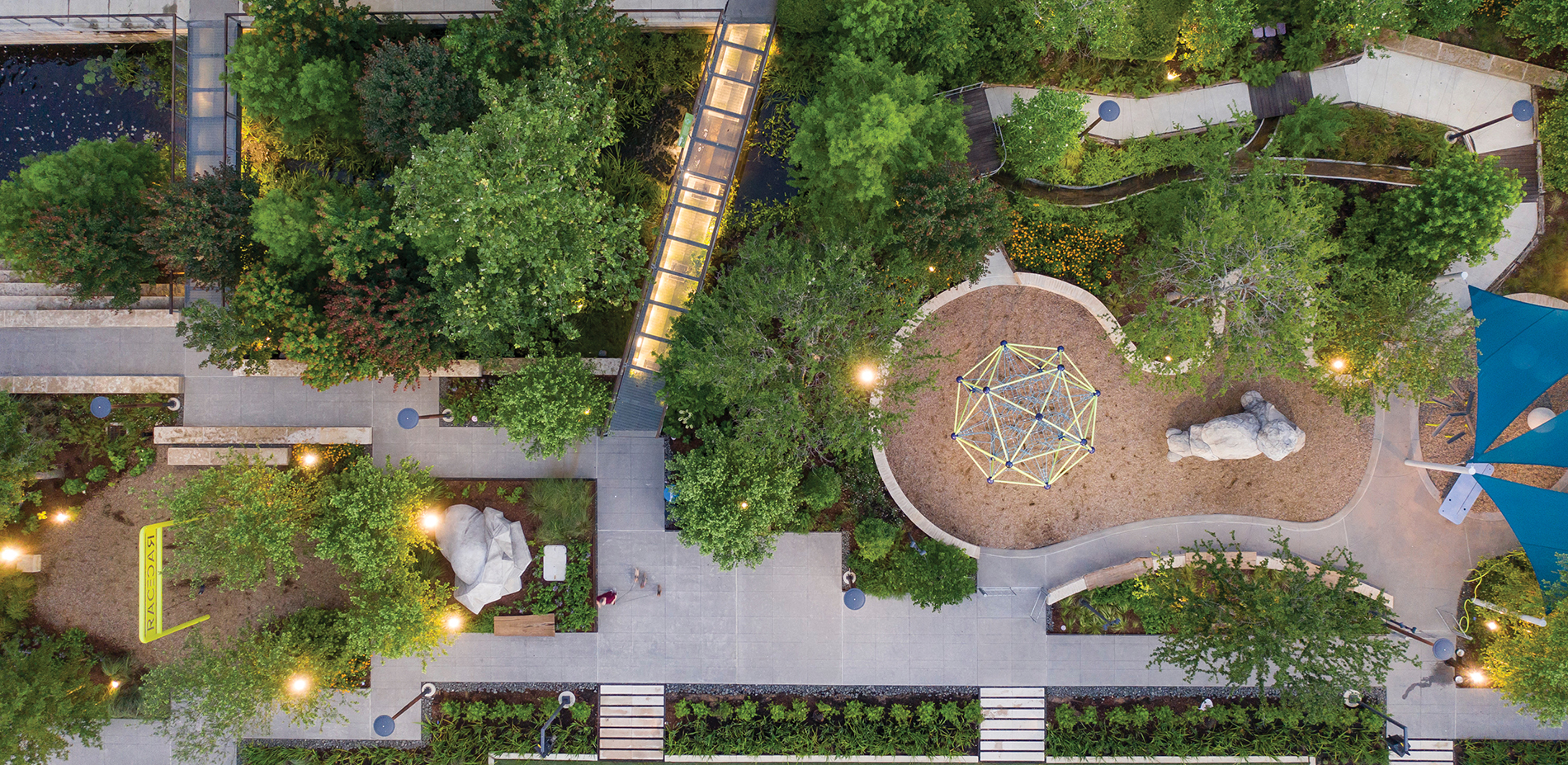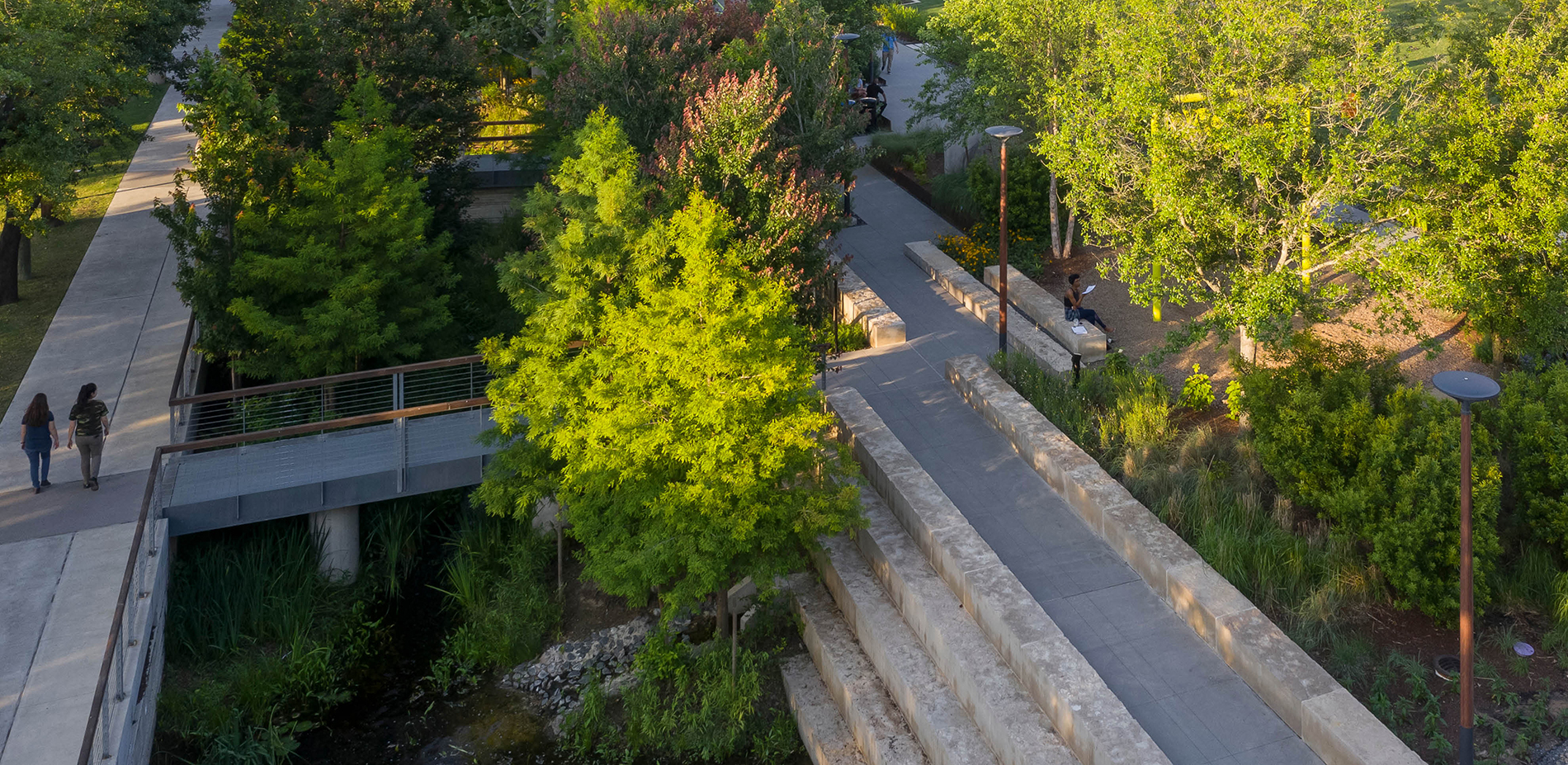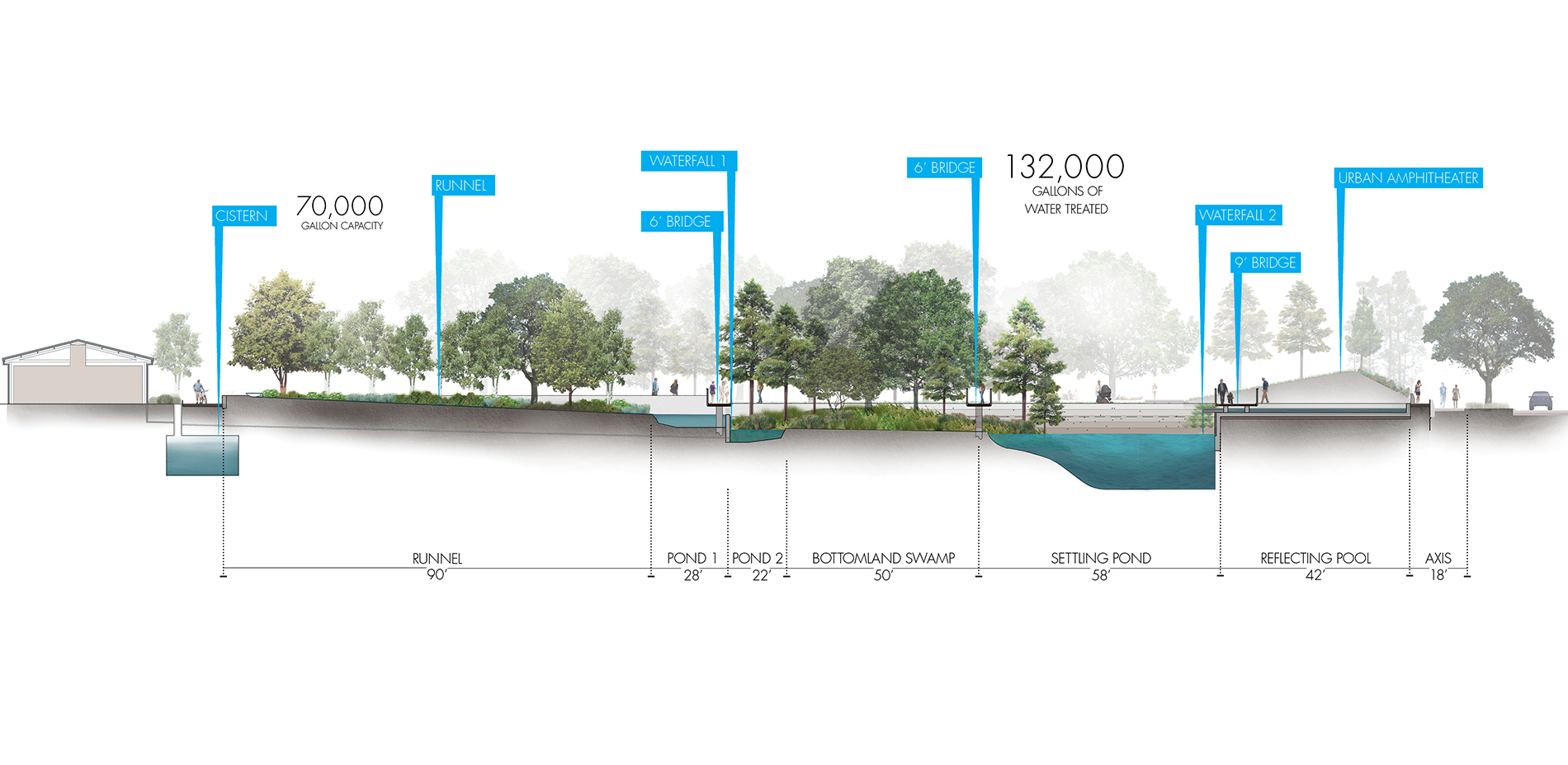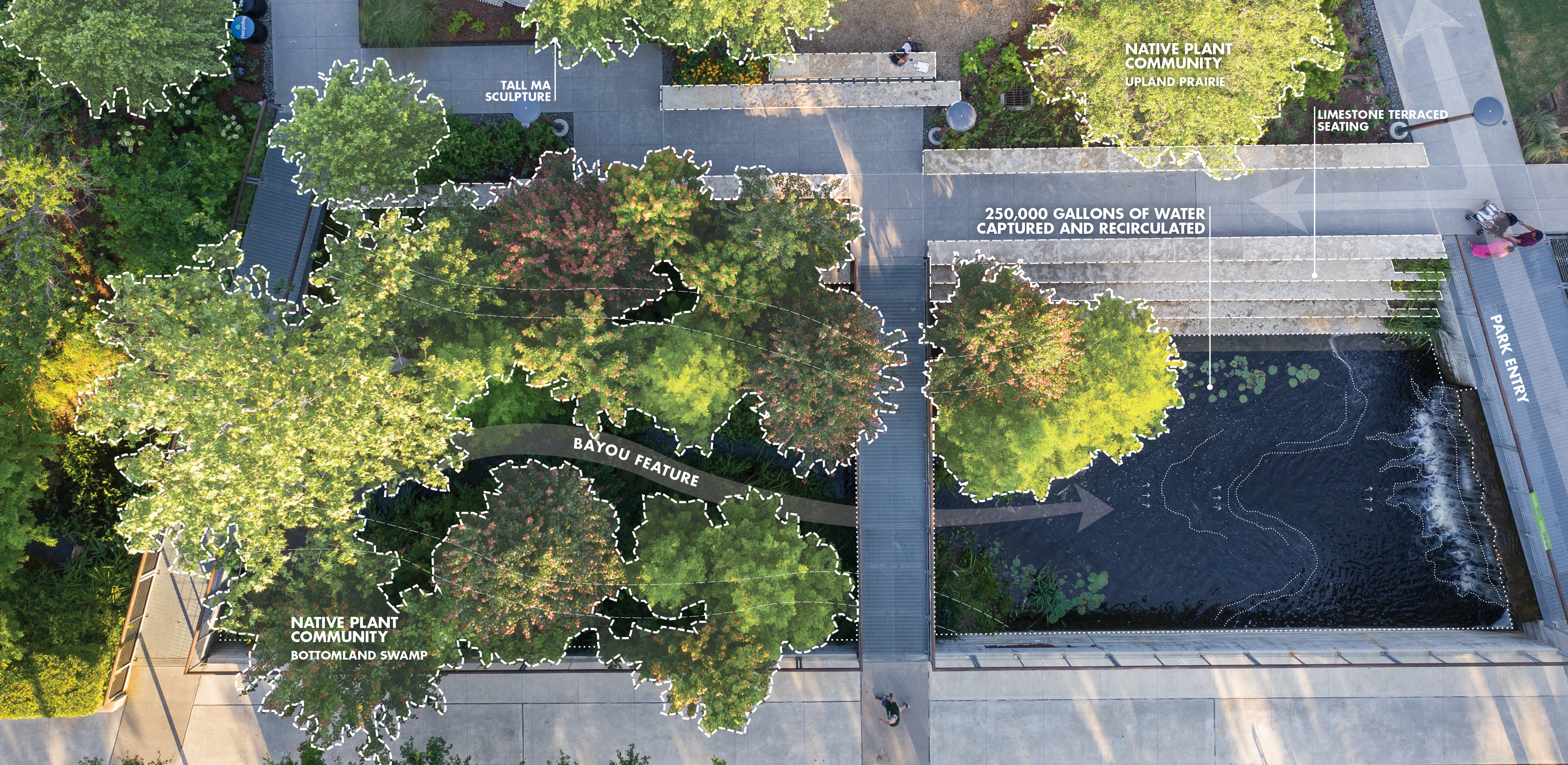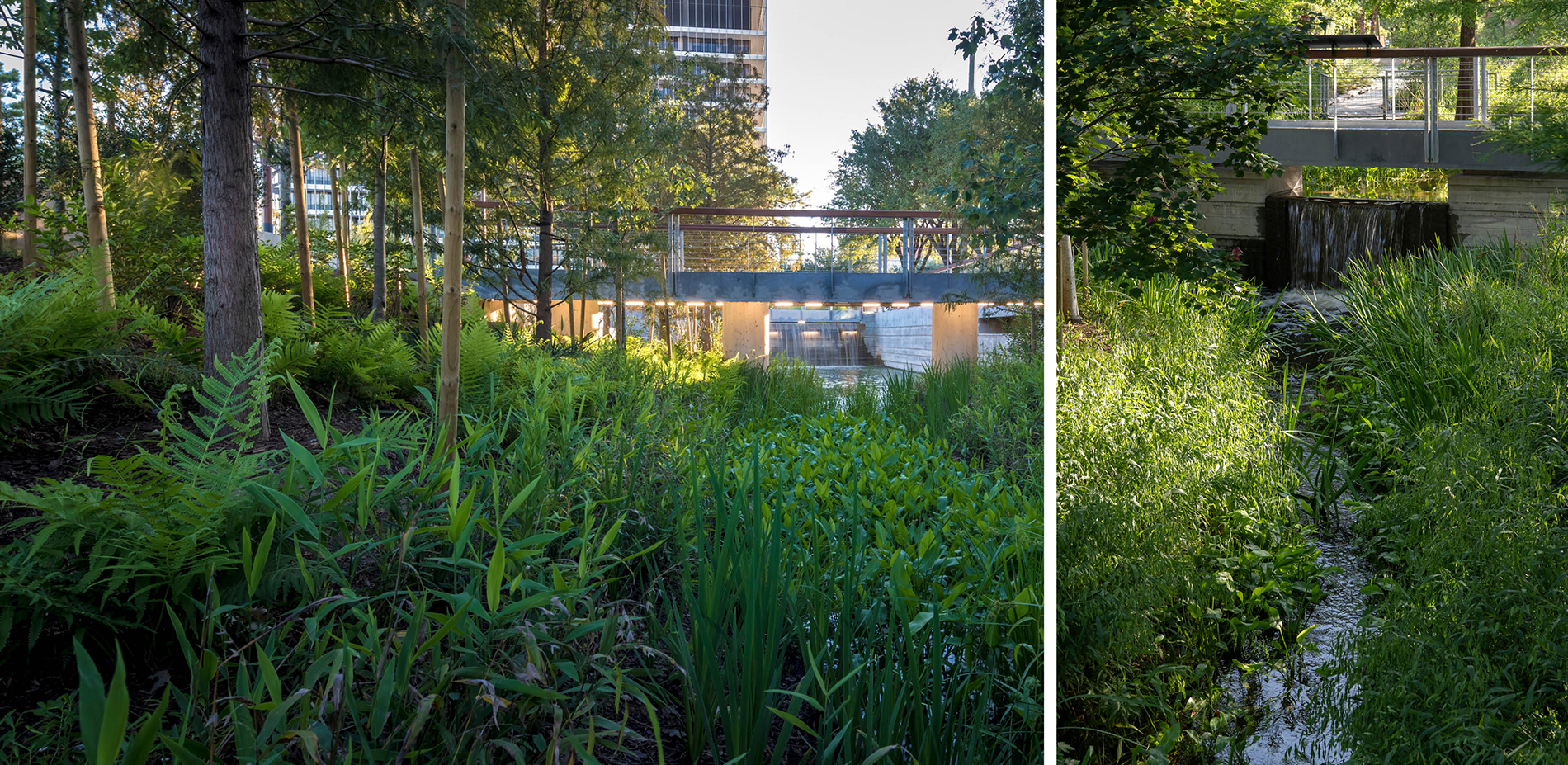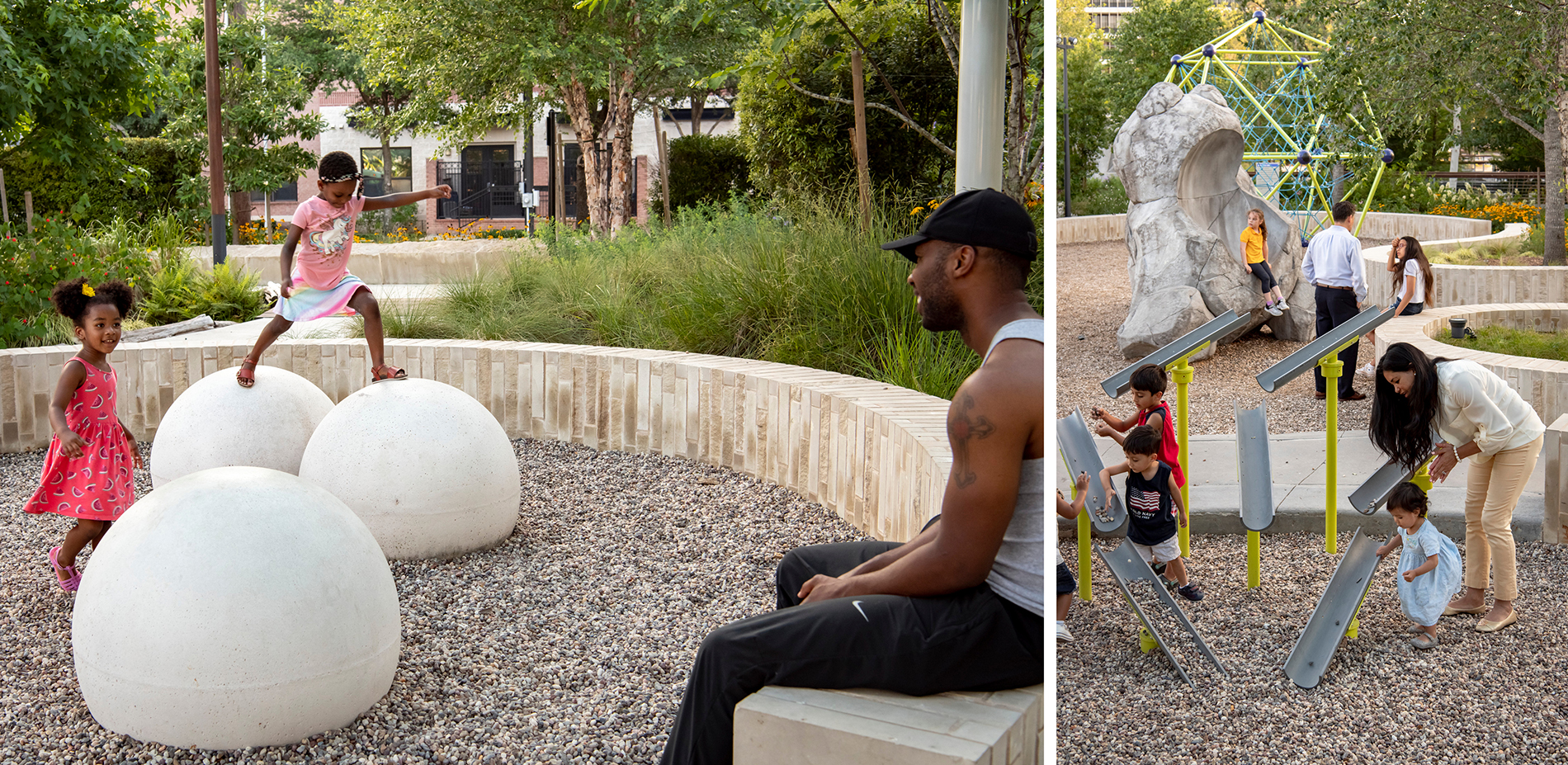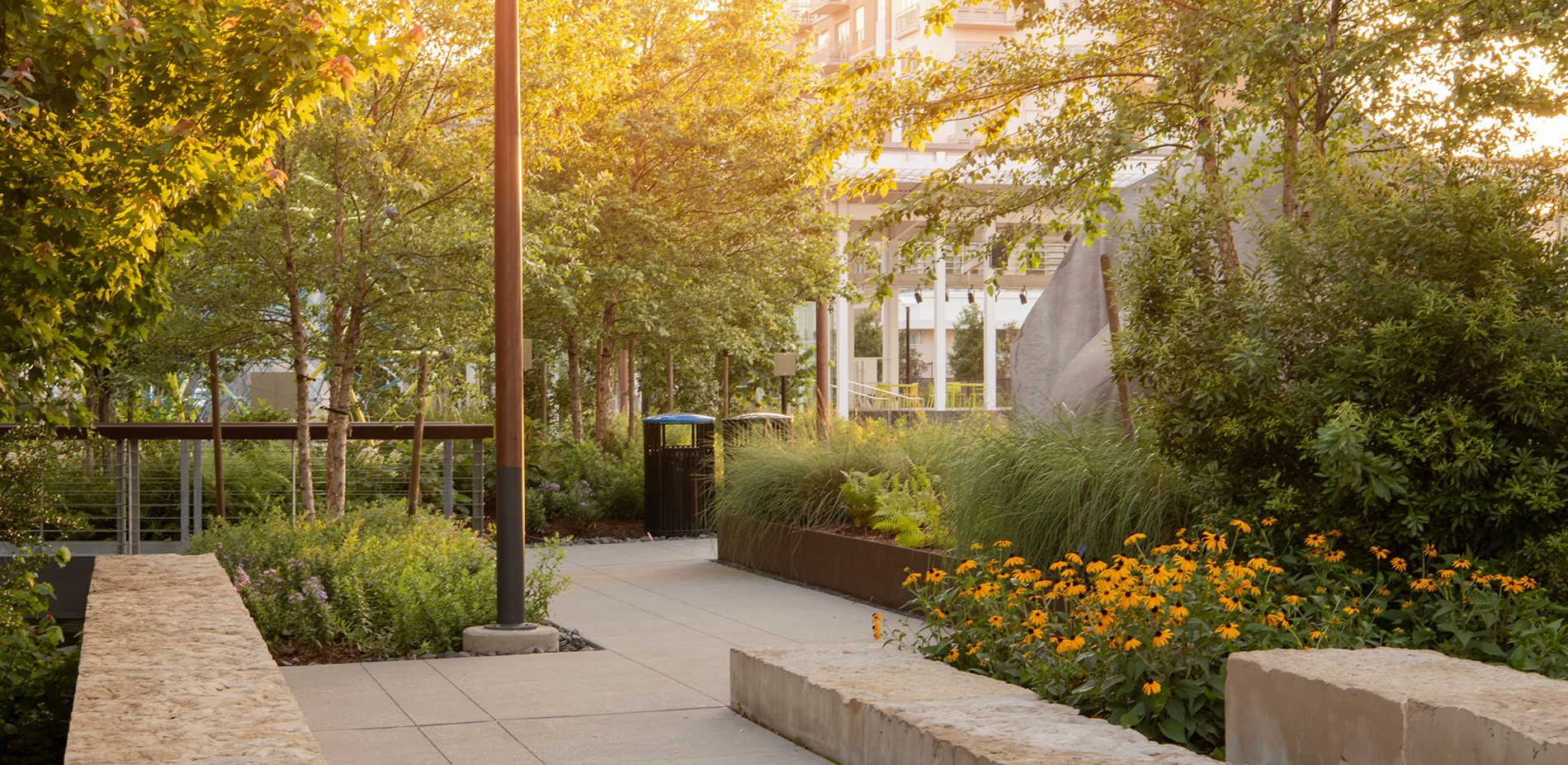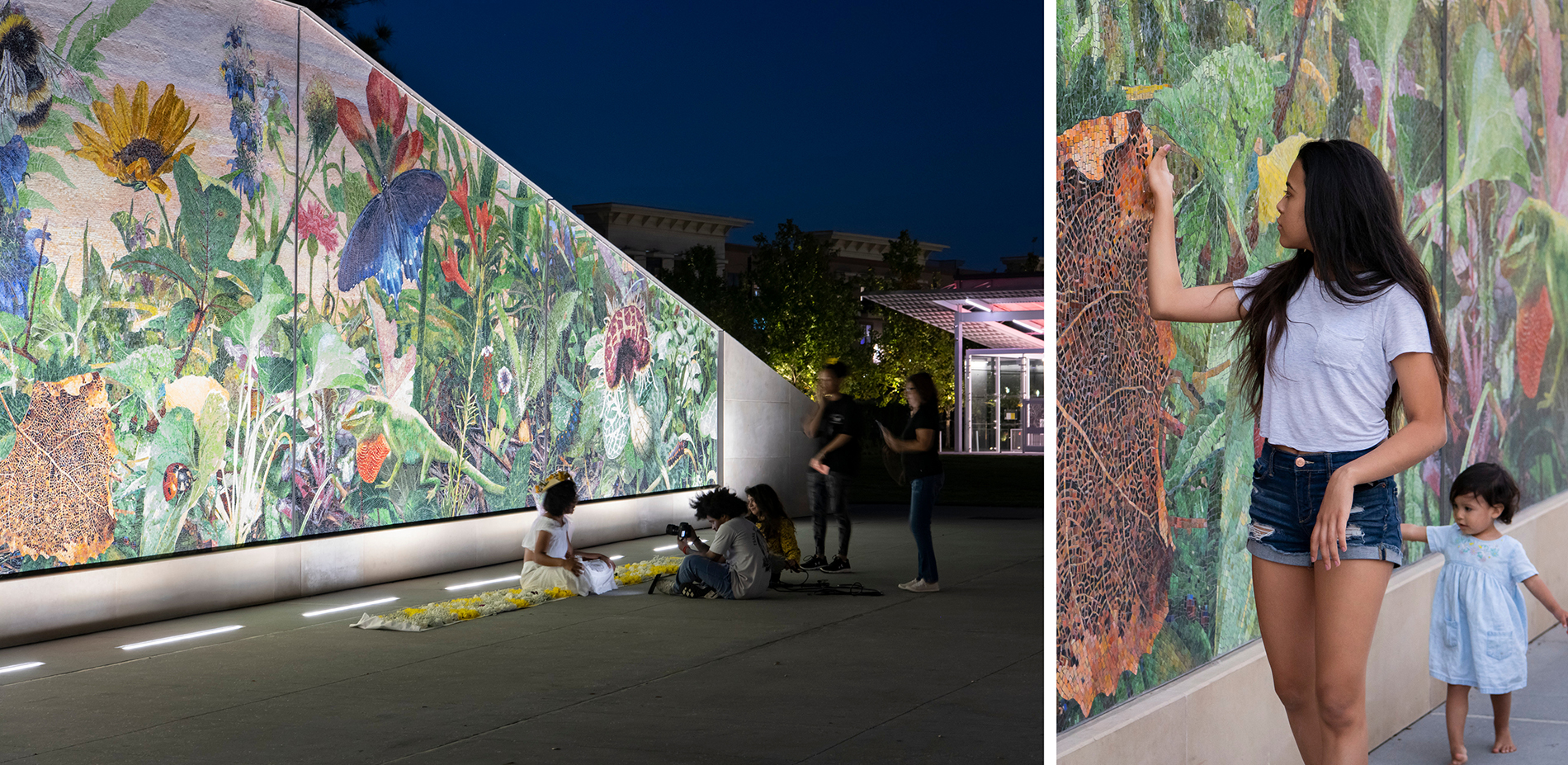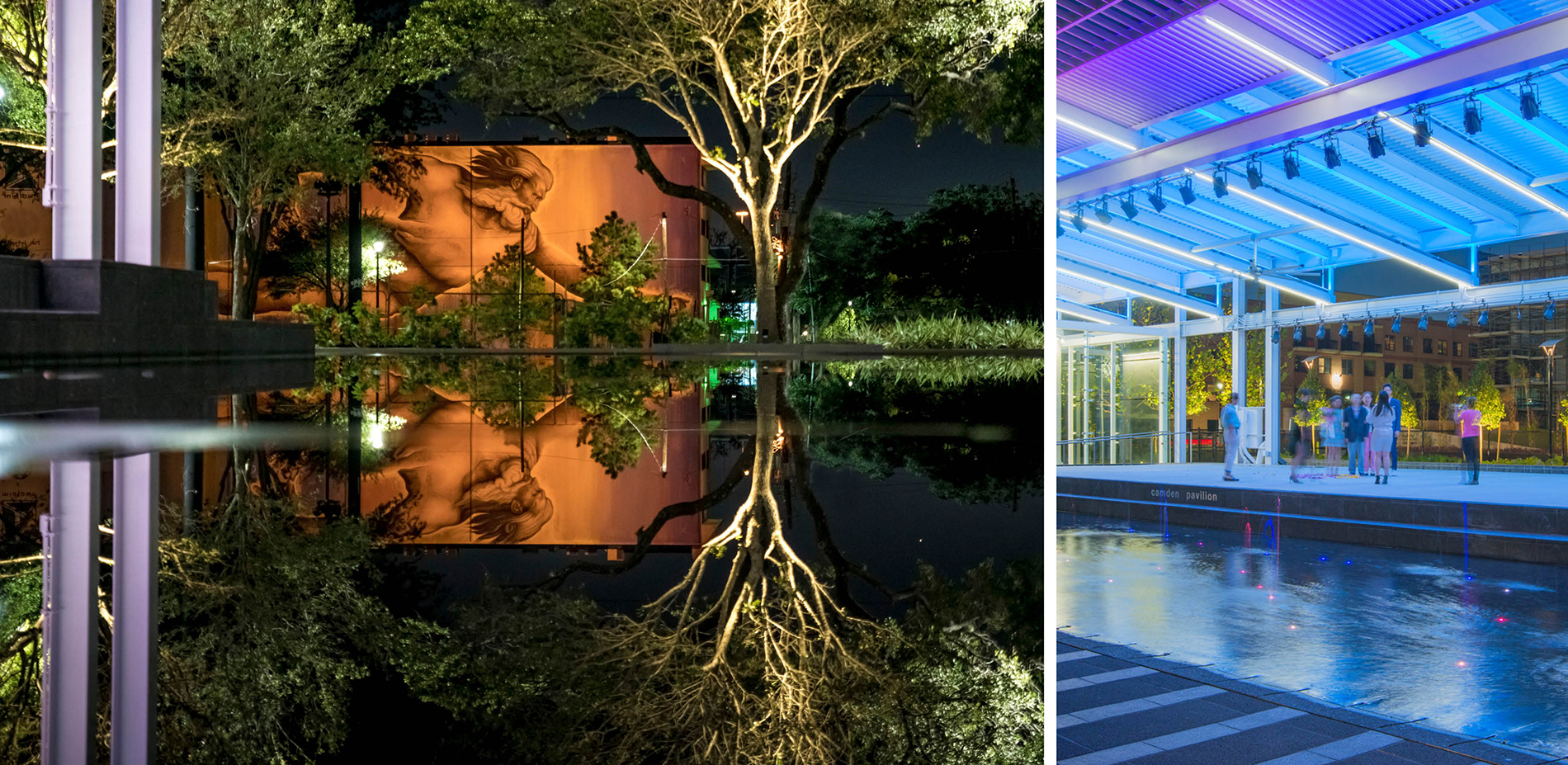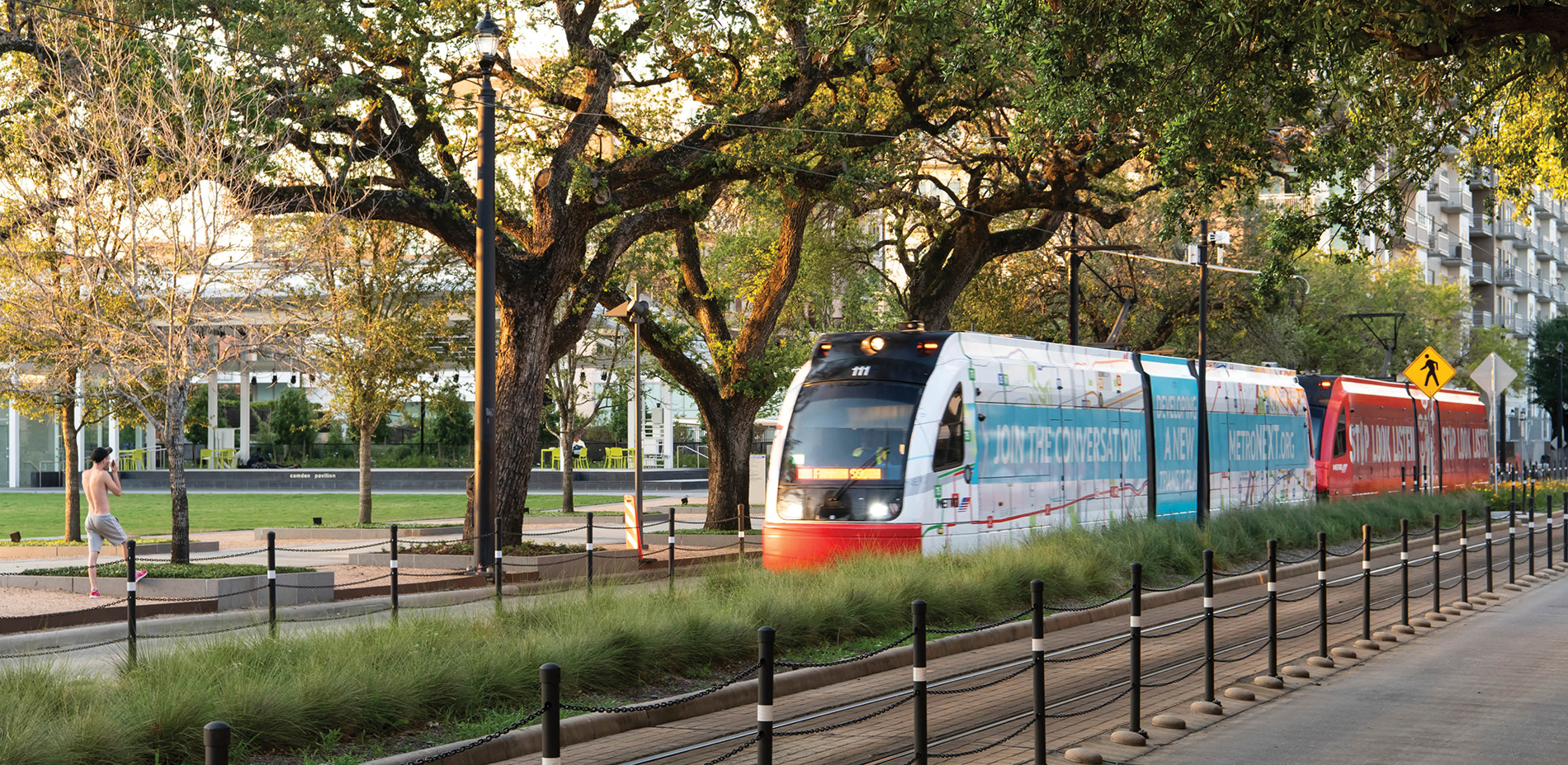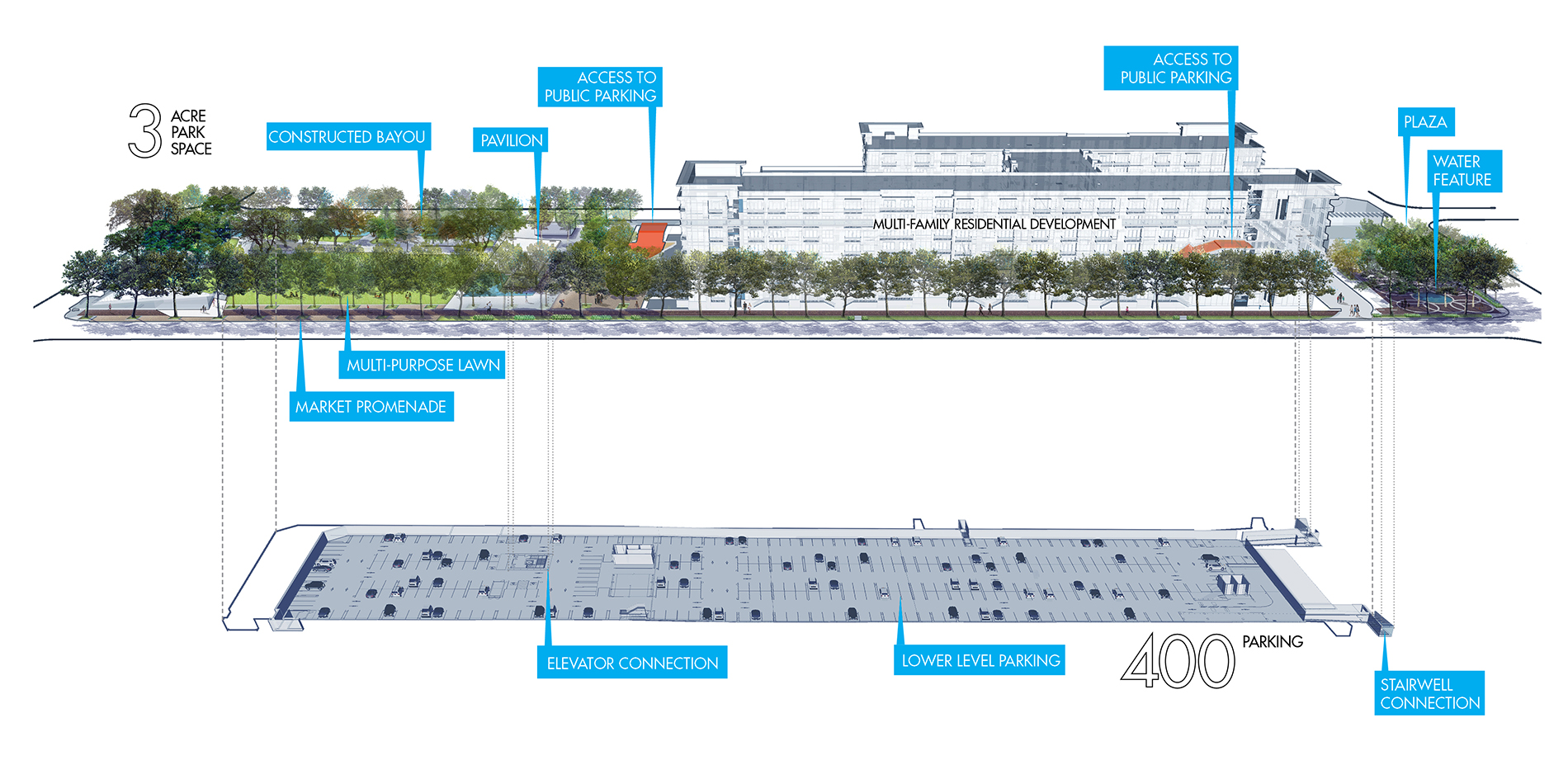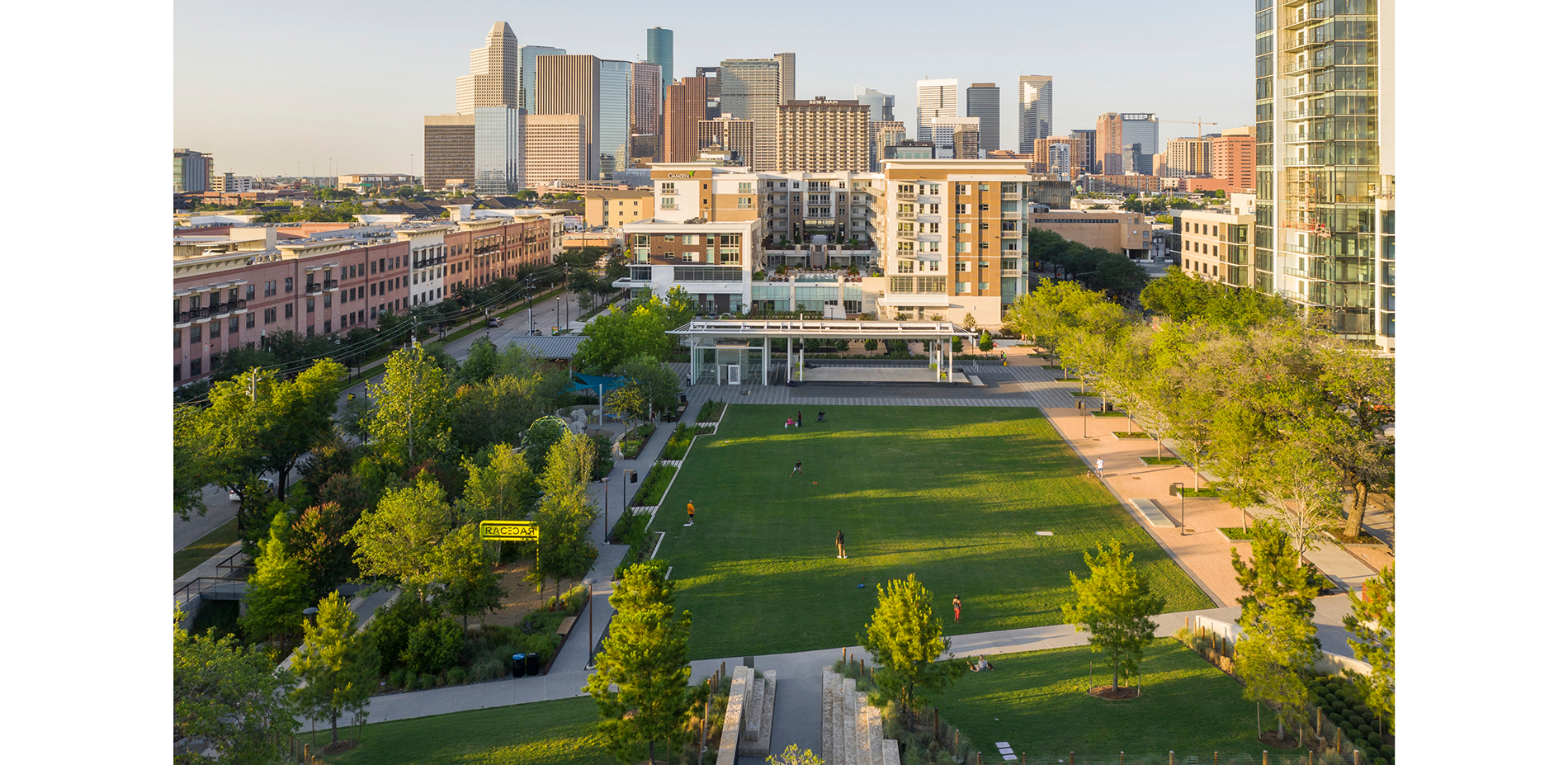Midtown Park
Honor Award
Urban Design
Houston, Texas, United States
Design Workshop, Inc.
Client: Midtown Redevelopment Authority
The once underused lawn is now activated with a performance pavilion, trails, marketplace, two restaurants, an arts garden, dog park, and social game courts. Bayou-inspired water features bring nature to the city to provide respite and sustainable water management – all built on top of a public underground parking garage. Rainwater is collected and stored within a 70,000-gallon subsurface cistern. Midtown Park serves as an early demonstration project for the ongoing development of a greener, more walkable Houston.
- 2022 Awards Jury
Project Credits
Alex Ramirez, Alex Hill, Sarah Delcambre, Steven Spears, Phillip Koske, Amy Harbert, Steve Moore, Jason Ferster, Sommer McNamara, Design Workshop, Inc.
Walter P. Moore (Prime Consultant), Civil Engineer
Walter P. Moore, Structural Engineer
Urban Architecture, Architect
Water Design Inc., Fountain Designer
Regenerative Environmental Design, Sustainability Consultant
JAS Irrigation Design, Irrigation Design
Millis Development and Construction, General Contractor
HLS Landscape, Landscape Contractor
Dixie Friend Gay, Wild Wonderland Mosaic Mural Artist
Project Statement
The opening of Midtown Park fulfills a decade long dream to rejuvenate Midtown Houston. In 2010, the Midtown Redevelopment Authority (MRA) and design team strategized revitalizing this neighborhood, which historically struggled. A vision plan was adopted that identified catalyst projects to help overcome the social, environmental, and economic disparities plaguing the community. Facilitated by Houston’s absence of zoning and aging infrastructure, the district lacked cohesiveness, desirable and affordable housing, connectivity, and green open spaces. The capstone project, Midtown Park, brings these elements together as the premier destination for the (now) “most walkable neighborhood” in Houston.
The Midtown Park superblock provides much-needed housing, commercial space, and (subsurface) off-street parking as well as nature, art, stormwater detention, and community gathering areas. This vibrant, urban park improves access to green space and amenities for visitors while creating a balance of active and passive recreational opportunities within the park’s signature spaces. Slated to be the first SITES project in Houston, Midtown Park represents sustainability and resilience in one of the nation’s largest and most diverse cities.
Project Narrative
Many know Houston as the commuter, flood-prone city without zoning. Fewer know it as the most diverse city in the United States. The design team was commissioned by the Midtown Redevelopment Authority (MRA) to reimagine and rebrand the district as a vibrant pedestrian-oriented, mixed-use hub. Through strategic planning efforts and a collection of catalyst project investments, Midtown is now considered the most walkable place to live in Houston. Midtown Park, the culminating effort, provides residents and visitors a true urban park.
Over the last fifty years, many attempts were made to revitalize Midtown. However, a lack of distinguishable community character and identity as well as aging infrastructure continuously saw businesses move to the cost-effective suburbs. In the 1990s, grassroots efforts formed the MRA, an organization dedicated to the growth and prosperity of the district. The MRA immediately petitioned the city to define Midtown as an arts and entertainment district supported by a Tax Increment Reinvestment Zone (TIRZ). This set the stage. Midtown, with its superb location, TIRZ support, and new designation, was ready to reach its full potential.
A holistic revitalization effort commenced in 2010 with a Livable Center Study, which sought to recommend strategies that could breathe new life into the Midtown District. The design team prepared a vision plan focused on identifying urban design mechanisms and pilot projects that would help the community address social, environmental, and economic issues as well as showcase the arts. The plan also provided recommendations to overcome Houston’s absence of zoning and aging infrastructure. The design team identified placemaking and resilience as critical success factors for catalytic implementation projects. The capstone of these projects, Midtown Park, is the premier destination for the (now) “most walkable neighborhood” in Houston.
VISION
The concept of a “central park” in Midtown was set in motion when the MRA established itself as an agency of change in Houston. MRA worked to acquire underutilized properties to capitalize on this opportunity. Upon acquisition, the MRA, developer, and design team worked in partnership over several years to develop the property into a hub of activity for the district.
CONTEXT
Midtown Park is the epicenter of Houston’s Midtown District, a growing neighborhood with renewed identity from public realm redevelopment. The 6-acre project site is a “superblock” created from inaccessible, privately owned, and unmaintained open fields, bounded by narrow sidewalks and several large existing oak trees, which were preserved and protected. The centerpiece of the property and larger parks system is Midtown Park, a 3-acre parcel activated with a performance pavilion, trails, marketplace, playgrounds, interactive fountain, an arts garden, dog park, and social game courts. Bayou-inspired water features bring nature to the city providing respite and sustainable water management – all built on top of a public underground parking garage. Midtown Park is a demonstration for the continued development of a greener, more walkable Houston that proves that high-quality public spaces are a crucial ingredient for successful, livable cities.
Challenged with creating the “premier urban park destination in Midtown”, the design team understood the park needed seamless integration into the district. They capitalized on the site’s geographic locale, proximity to transit, surrounding developments, and a need to place parking below grade. The design team successfully collaborated, designed, and implemented a park that serves the needs of the neighborhood and greater community as well as bolstered the integrity of the district’s brand through programming and innovative design features.
Midtown sits between two major employment hubs, Downtown and the Medical Center. The district made public streetscape investments in Midtown to foster growth. This increased walkability as well as demand for accessible park space; therefore, Midtown Park is a critical destination within the urban fabric of Houston, a city with one of the lowest Park Scores in the nation.
FEATURES
The location of the park immediately adjacent to Houston’s transit-oriented Main Street was strategically identified by the design team to ensure Midtown Park remained an equitable resource. With immediate access to transit, light rail, and bike share systems, Midtown Park has quickly become one of the most popular and frequently visited open spaces in the district, and park visitors exemplify Houston’s title as the most culturally diverse city in the United States.
Midtown Park is comprised of a wide variety of flexible, multi-functional spaces that can accommodate several events and programs such as markets and festivals, which create economic growth and a sense of community within the surrounding neighborhood. In support of the Midtown Strategic Plan and the Midtown Open Space Plan, the design of the park engages all age groups. To aid the continual evolution of the park, the design and layout focuses on flexible use, utilizing the large, centrally located, multi-purpose lawn, which is gently sloped to face the “Rain Fountain” adjacent to the stage. When not operational, the Rain Fountain (designed to mimic a Houston storm event by choreographing “rain drops” and “lightning”) can be transformed into additional plaza space for flexible seating during events.
Public art is a key component of the park’s design, and it can be seen throughout the park. The Midtown Parks Conservancy made significant investments in securing local, internationally recognized artists to install 4 permanent art pieces, cementing the park as an icon for the district.
The berms, just behind the event lawn, provide topographic relief in an area with unremarkably flat topography that provide views of Downtown’s skyline. Despite the berms, the park, with superb lighting, maintains a sense of transparency from corners and key pedestrian edges, such as Main Street, allowing the park to reach beyond its borders into the diverse community.
A challenge that proved surmountable was creating an environment where trees and gardens could thrive in adequate soil volumes and uphold a living, sustainable park above an underground parking garage with an intricate system of draining capabilities, robust waterproofing, pumps, and a rainwater cistern. The underground parking garage presented both an opportunity and a challenge, as the integration of much-needed parking helped to make the project viable in an area that is under extreme development pressure with little desire for surface lots.
RESILIENCE
The backbone of the site and key feature of the design was the integration of the “Bayou”, a constructed water channel and detention system, which mimics the natural bayous, swamps, bottomland hardwood forests and wetlands of Houston, all of which are integral pieces of the hydrology of the region. Working together with bioswales and rain gardens, these educational features were designed with an assortment of native plant materials typically found in this environment and has proven to enhance economic and ecological resiliency by protecting against flooding while improving water quality and wildlife habitat. During extreme rainfall events, like Hurricane Harvey, the bayou can absorb and detain stormwater preventing local flooding and property damage.
Rainwater is collected and stored within a 70,000-gallon subsurface cistern. The water is reused on-site for irrigating plant material or as “make-up” water for the recirculating Midtown Bayou. When there is excess water, such as during large rain events, an overflow structure moves water directly to the constructed bayou, where it is held and treated by the plants and soils before release into the municipal storm sewer system. This layered and integrated approach to stormwater management takes pressure off over-burdened infrastructural systems and helps to cleanse water through natural infiltration. As the premier park destination in Midtown, the successful integration of highly complex stormwater management systems and a commitment to the responsible use of resources was vital for the development. The park’s sustainability measures offer a new model to Houstonians – SITES Silver certification.
Products
-
Fences/Gates/Walls
- Alamo Stone
-
Irrigation
- Hunter Industries
- Rain Bird
- Baseline
-
Soils
- All soils came from within a 250-mile radius of the site to ensure that requirements for SITES accreditation were met.
-
Hardscape
- Cold Springs Granite
- PavestoneAlamo Stone
-
Lighting
- Bega
- Ecosense
Plant List
- Swamp Red Maple
- River Birch
- American Hornbeam
- Texas Redbud
- Forest Pansy Redbud
- Savannah Holly
- Sweet Gum
- Sweet Bay Magnolia
- Loblolly Pine
- Mexican Sycamore
- Bald Cypress
- Live Oak
- Yarrow
- Maidenhair Fern
- Agapanthus
- Bushy Bluestem
- Columbine
- Artemisia
- River Cane
- Butterfly Weed
- Foxtail Fern
- Fall Aster
- Sideoats Grama
- American Beautyberry
- Horseherb
- Showa-No-Sakae Sasanqua Camellia
- Water Sedge
- Variegated Sedge
- Texas Sedge
- Night Jasmine
- Inland Sea Oats
- Roughleaf Dogwood
- Parsley Hawthorn
- Montbretia
- Flax Lily
- Pink Coneflower
- White Coneflower
- Fig Ivy
- Carolina Jessamine
- Witch Hazel
- Daylily
- Red Yucca
- Endless Summer Hydrangea
- Oakleaf Hydrangea
- Dahoon Holly
- Possumhaw
- Dwarf Yaupon Holly
- Louisiana Iris (purple)
- Sweetspire
- Mexican Honeysuckle
- Red Lantana
- Snowflake
- Spicebush
- Coral Honeysuckle
- Dwarfs Turks Cap
- Big Muhly
- Gulf Muhly
- Deer Muhly
- Wax Myrtle
- Mexican Feathergrass
- Water Lily (native)
- Golden Club
- Virginia Creeper
- Texas Frogfruit
- Plumbago
- George Taber Azalea
- Trailing Rosemary
- Upright Rosemary
- Black-eyed Susan
- Dwarf Palmetto
- Autumn Sage
- Mexican Bush Sage
- Lizard's Tail
- Little Bluestem
- Bridal Wreath Spirea
- Coralberry
- Southern Wood Fern
- Asian Jasmine
- Purple Heart
- Sparkleberry
- Purple Verbena
- White Verbena
- Sandankwa Viburnum
- Goldeneye
- Bermuda Grass
